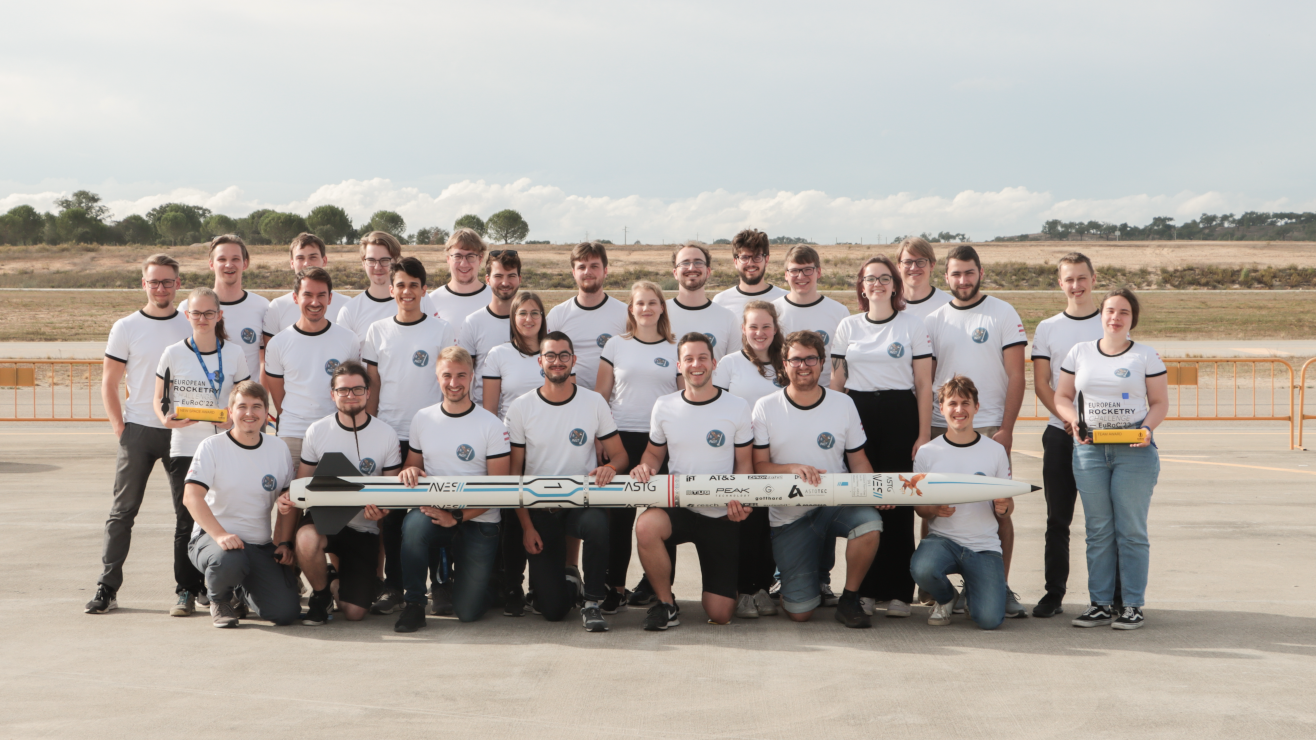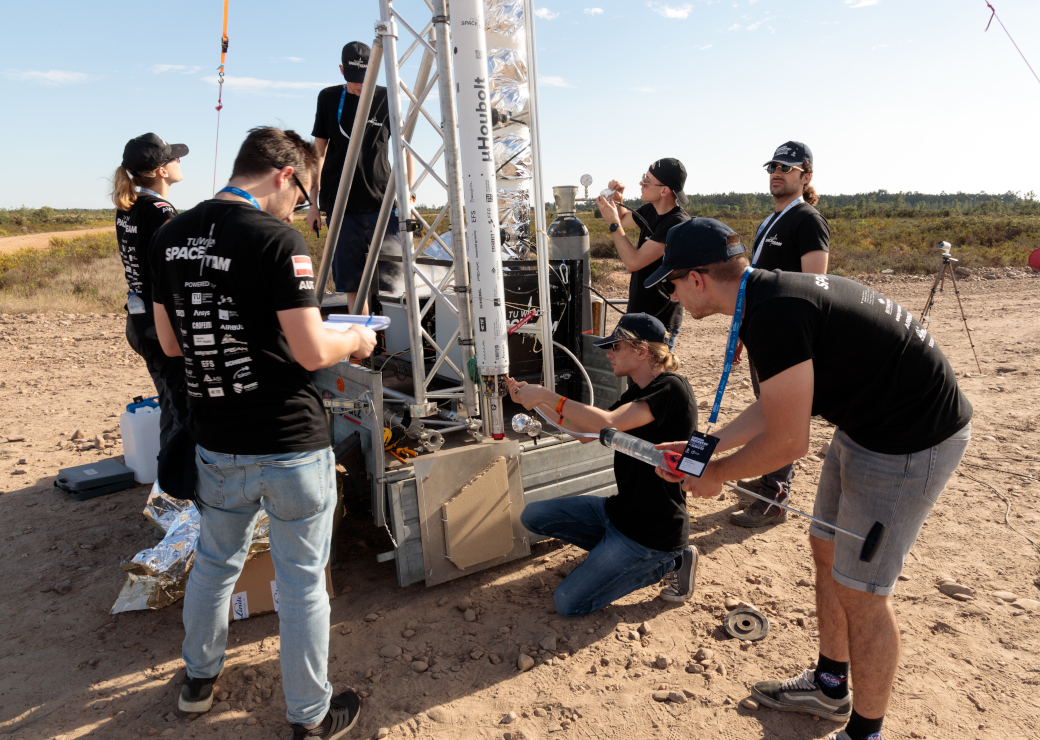Success for rockets of Graz and Vienna students in Portugal at EUROC 2022
Aerospace Team Graz flying high
After almost a year of project work, in October the time had come: Aerospace Team Graz (ASTG) launched its competition rocket "AVES II" at the "European Rocketry Challenge 2022" in Portugal and achieved great success.
This competition is all about precision: 25 student teams from all over Europe come together to try to reach a target altitude as accurately as possible with homemade rockets. There are different types of propulsion.
ASTG had chosen a solid rocket motor to propel our rocket, including a 4 kg payload, to 3000 meters.
The rocket, which weighs 33 kg and is 3.6 m long, reaches a speed of about 1100 km per hour.
In addition to launching the rocket, the team members also had to answer questions from the experts in the jury and present the unique properties of the AVES II rocket. The Graz team was able to impress and took home 2 trophies.
The "New Space Award" honors the best jury pitch of the project and the presentation of the team as launch provider. For the "Team Award" we could convince with reliability, teamwork, organization and communication.
The association, which was founded 3 years ago, now counts almost 80 student members.
The interest in rocketry and in the space sector in general is great - we are also happy that 14 different degree programs from various universities in Graz are represented here,
The team works on the principle of developing and building as many rocket components as possible themselves. This is made possible for the students primarily through partnerships with Austrian companies. Now, ASTG continues to pursue its goal of getting people excited about technology and science, and perhaps hosting a rocket event in Austria.
Text: Georg Witzlinger, ASTG
LAUNCH DAY - AVES II European Rocketry Challenge 2022
The video is provided via Youtube , a connection to the servers of Youtube is established (see privacy policy).
TU Vienna Space Team develops liquid-fueled rocket
Successful flight of a completely new rocket: The same technology used by NASA, ESA or SpaceX now allows rockets of the TU Vienna Space Team to take off.
Smaller rockets, such as those developed by student teams around the world, usually use solid fuels. But where high efficiency, controllability and reusability of engines are important, liquid engines are a better choice.
That's why large launch vehicles, from the Saturn rockets of the Apollo program to SpaceX's rockets, always use liquid propellants. However, this is technically much more difficult than using solid fuels.
The TU Vienna Space Team had repeatedly launched solid-fuel rockets with success. At the same time, they had been working on the development of their own liquid rocket for years. Even a separate test stand for engine development was constructed for this purpose. Now the project has been crowned with success: at the international "European Rocketry Challenge" in Portugal, the TU Vienna team was the only one to compete with a liquid rocket - and the launch was successful.
Technical problem solving in many areas
The road to success was long and arduous: liquid rocket engines are incomparably more complicated than ordinary solid rocket engines, such as those familiar from New Year's Eve fireworks. Different working groups within the TU Vienna Space Team had to solve very different problems.
One had to deal with difficult questions from fluid mechanics to ensure that the liquid propellant, whose components are stored in two separate tanks, are combined in exactly the right way. One team had the task of designing appropriate ignition technology. After developing their own electronics for the engine - and the more they learned about what complex requirements had to be met for a liquid rocket launch, the more complicated the control electronics became.
Once they had developed a functional rocket engine, however, they still had to build the rocket itself - fortunately, this is the area in which the TU Vienna Space Team already had a lot of experience: A rocket with a length of 2m was constructed into which the novel propulsion system could be installed. It was particularly important to the TU Vienna Space Team to develop a compact and lightweight design in order to achieve optimal performance.
First attempt - with half success
Month after month we made progress as we worked towards the European Rocketry Challenge. We knew: there are so many technical problems to solve that it will definitely be tight.
The team had scheduled one major test before they made the trip to the competition in Portugal: on June 25, 2022, at the model airfield in Straubing, Germany, the new rocket was to pass its practical test. For the first time in the history of the TU Vienna Space Team, a liquid rocket was ignited - the propulsion system behaved as planned, the parachutes were also triggered correctly, but the wind was too strong, the parachutes tore out, and instead of a soft landing, there was a violent crash, the rocket hit the ground and was broken.
This left the team with only three months to build a completely new rocket for the European Rocketry Challenge.
This was extremely hard work. Some of us didn't sleep very much during that time.
Until the last day, the team worked, tested and optimized - until they finally set off for Portugal - as the only team with a liquid rocket.
Outstanding success in Portugal
In Portugal, the weather was not kind to the TU Wien Space Team at first: the launch had to be postponed several times, and they also had to deal with minor technical problems. But on October 16, 2022 at 14:12, the team finally received the green light for the rocket launch.
The engine ignited, the valves worked correctly and produced the right propellant mixture, the necessary thrust was achieved, then the rocket mount was automatically released - and the rocket lifted off. Six seconds of burn time enabled a flight altitude of 2200 meters. At the summit, the tip was separated, a parachute was ejected and the rocket returned to earth. At 250 meters, the larger main parachute had been ejected, and thus a soft landing was achieved according to plan.
It was the first liquid rocket flight with successful recovery of the rocket ever achieved by a European student team - a great success for the team after years of work, which also impressed the other teams and the jury of the European Rocketry Challenge. Now all construction plans, the self-programmed software and the measured data are to be published as open source - to enable other rocketry teams around the world to build on the TU Vienna Space Team's findings.
Text: Florian Aigner


